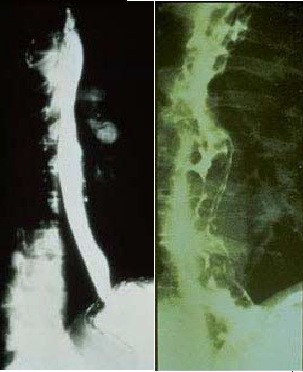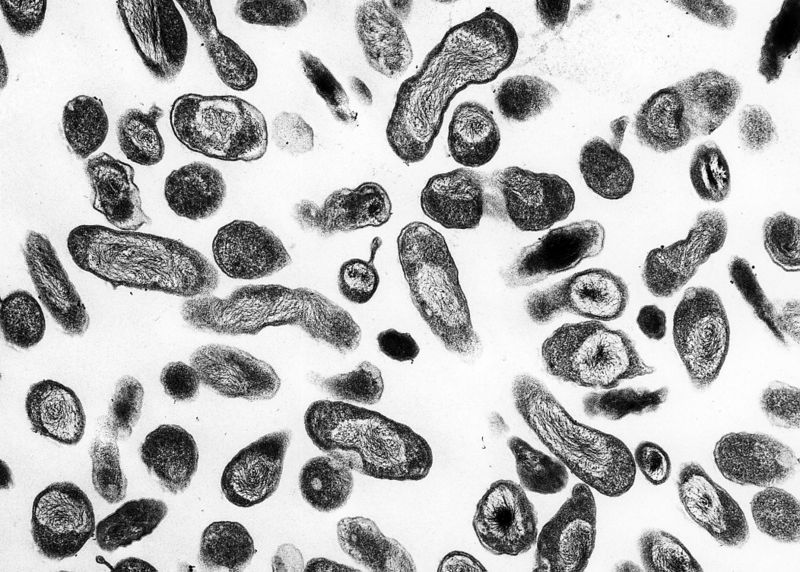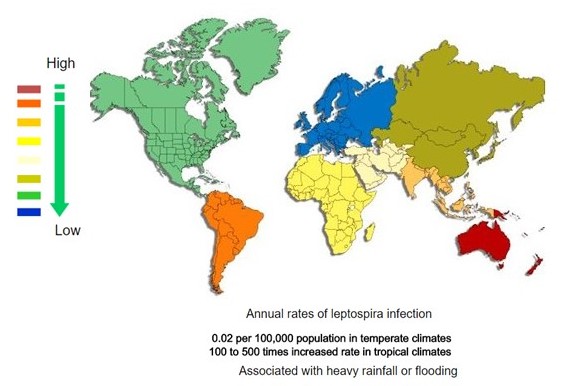Sandbox:Cherry
Patient information
For the WikiDoc page for this topic, click here
|
Diarrhea |
|
Diarrhea On the Web |
|---|
Editor-In-Chief: C. Michael Gibson, M.S., M.D. [1]; Assistant Editor-in-Chief: Meagan E. Doherty
Overview
Diarrhea is loose, watery stools. A person with diarrhea typically passes stool more than three times a day. People with diarrhea may pass more than a quart of stool a day. Acute diarrhea is a common problem that usually lasts 1 or 2 days and goes away on its own without special treatment. Prolonged diarrhea persisting for more than 2 days may be a sign of a more serious problem and poses the risk of dehydration. Chronic diarrhea may be a feature of a chronic disease. Diarrhea can cause dehydration, which means the body lacks enough fluid to function properly. Dehydration is particularly dangerous in children and older people, and it must be treated promptly to avoid serious health problems. People of all ages can get diarrhea and the average adult has a bout of acute diarrhea about four times a year. In the United States, each child will have had seven to 15 episodes of diarrhea by age 5.
What are the symptoms of Diarrhea?
Diarrhea may be accompanied by cramping, abdominal pain, bloating, nausea, or an urgent need to use the bathroom. Depending on the cause, a person may have a fever or bloody stools.
What are the causes of Diarrhea?
Acute diarrhea is usually related to a bacterial, viral, or parasitic infection. Chronic diarrhea is usually related to functional disorders such as irritable bowel syndrome or inflammatory bowel disease.
A few of the more common causes of diarrhea include the following:
- Bacterial infections. Several types of bacteria consumed through contaminated food or water can cause diarrhea. Common culprits include Campylobacter, Salmonella, Shigella, and Escherichia coli (E. coli).
- Viral infections. Many viruses cause diarrhea, including rotavirus, Norwalk virus, cytomegalovirus, herpes simplex virus, and viral hepatitis.
- Food intolerances. Some people are unable to digest food components such as artificial sweeteners and lactose—the sugar found in milk.
- Parasites. Parasites can enter the body through food or water and settle in the digestive system. Parasites that cause diarrhea include Giardia lamblia, Entamoeba histolytica, and Cryptosporidium.
- Reaction to medicines. Antibiotics, blood pressure medications, cancer drugs, and antacids containing magnesium can all cause diarrhea.
- Intestinal diseases. Inflammatory bowel disease, colitis, Crohn’s disease, and celiac disease often lead to diarrhea.
- Functional bowel disorders. Diarrhea can be a symptom of irritable bowel syndrome.
Some people develop diarrhea after stomach surgery or removal of the gallbladder. The reason may be a change in how quickly food moves through the digestive system after stomach surgery or an increase in bile in the colon after gallbladder surgery.
People who visit foreign countries are at risk for traveler’s diarrhea, which is caused by eating food or drinking water contaminated with bacteria, viruses, or parasites. Traveler’s diarrhea can be a problem for people visiting developing countries. Visitors to the United States, Canada, most European countries, Japan, Australia, and New Zealand do not face much risk for traveler’s diarrhea.
In many cases, the cause of diarrhea cannot be found. As long as diarrhea goes away on its own, an extensive search for the cause is not usually necessary.
Who is at risk for Diarrhea?
Anyone can get diarrhea. This common problem can last a day or two or for months or years, depending on the cause. Most people get better on their own, but diarrhea can be serious for babies and older people if lost fluids are not replaced. Many people throughout the world die from diarrhea because of the large volume of water lost and the accompanying loss of salts.
Diagnosis
Diagnostic tests to find the cause of diarrhea may include the following:
- Medical history and physical examination. The doctor will ask you about your eating habits and medication use and will examine you for signs of illness.
- Stool culture. A sample of stool is analyzed in a laboratory to check for bacteria, parasites, or other signs of disease and infection.
- Blood tests. Blood tests can be helpful in ruling out certain diseases.
- Fasting tests. To find out if a food intolerance or allergy is causing the diarrhea, the doctor may ask you to avoid lactose, carbohydrates, wheat, or other foods to see whether the diarrhea responds to a change in diet.
- Sigmoidoscopy. For this test, the doctor uses a special instrument to look at the inside of the rectum and lower part of the colon.
- Colonoscopy. This test is similar to a sigmoidoscopy, but it allows the doctor to view the entire colon.
- Imaging tests. These tests can rule out structural abnormalities as the cause of diarrhea.
When to seek urgent medical care
Diarrhea is not usually harmful, but it can become dangerous or signal a more serious problem. You should see the doctor if you experience any of the following:
- Diarrhea for more than 3 days
- Severe pain in the abdomen or rectum
- A fever of 102 degrees or higher
- Blood in your stool or black, tarry stools
- Signs of dehydration
Treatment options
In most cases of diarrhea, replacing lost fluid to prevent dehydration is the only treatment necessary. Medicines that stop diarrhea may be helpful, but they are not recommended for people whose diarrhea is caused by a bacterial infection or parasite. If you stop the diarrhea before having purged the bacteria or parasite, you will trap the organism in the intestines and prolong the problem. Rather, doctors usually prescribe antibiotics as a first-line treatment. Viral infections are either treated with medication or left to run their course, depending on the severity and type of virus.
Tips About Food
Until diarrhea subsides, try to avoid caffeine, milk products, and foods that are greasy, high in fiber, or very sweet. These foods tend to aggravate diarrhea.
As you improve, you can add soft, bland foods to your diet, including bananas, plain rice, boiled potatoes, toast, crackers, cooked carrots, and baked chicken without the skin or fat. For children, the pediatrician may also recommend a bland diet. Once the diarrhea has stopped, the pediatrician will likely encourage children to return to a normal and healthy diet if it can be tolerated.
Contraindicated medications
Patients diagnosed with Diarrhea should avoid using the following medications:
- Ethacrynic acid
If you have been diagnosed with Diarrhea, consult your physician before starting or stopping any of these medications.
Where to find medical care for Diarrhea
Directions to Hospitals Treating Diarrhea
Prevention of Diarrhea
- Wash your hands often, especially after going to the bathroom and before eating.
- Teach children to not put objects in their mouth.
- When taking antibiotics, try eating food with Lactobacillus acidophilus, a healthy bacteria. This helps replenish the good bacteria that antibiotics can kill. Yogurt with active or live cultures is a good source of this healthy bacteria.
- Use alcohol-based hand gel frequently.
Traveler’s diarrhea happens when you consume food or water contaminated with bacteria, viruses, or parasites. You can take the following precautions to prevent traveler’s diarrhea when you travel outside of the United States:
- Do not drink tap water or use it to brush your teeth.
- Do not drink unpasteurized milk or dairy products.
- Do not use ice made from tap water.
- Avoid all raw fruits and vegetables, including lettuce and fruit salads, unless they can be peeled and you peel them yourself.
- Do not eat raw or rare meat and fish.
- Do not eat meat or shellfish that is not hot when served.
- Do not eat food from street vendors.
You can safely drink bottled water—if you are the one to break the seal—along with carbonated soft drinks, and hot drinks such as coffee or tea.
Depending on where you are going and how long you will stay, your doctor may recommend that you take antibiotics before leaving to protect you from possible infection.
What to expect (Outlook/Prognosis)
The Prognosis for diarrhea is usually good. Diarrhea is common and usually goes away on its own unless it is an underlying symptom of a chronic disease. It is important to replace lost fluid due to diarrhea because if you become severely dehydrated it can be fatal.
Sources
http://digestive.niddk.nih.gov/ddiseases/pubs/diarrhea/
Classification
Classification
There are at least four types of diarrhea: secretory diarrhea, osmotic diarrhea, motility-related diarrhea, and inflammatory diarrhea.
Secretory Diarrhea
Secretory diarrhea means that there is an increase in the active secretion, or there is an inhibition of absorption. There is little to no structural damage. The most common cause of this type of diarrhea is a cholera toxin that stimulates the secretion of anions, especially chloride ions. Therefore, to maintain a charge balance in the lumen, sodium is carried with it, along with water.
Osmotic Diarrhea
Osmotic diarrhea occurs when there is a loss of water due to a heavy osmotic load. This can occur when there is maldigestion (e.g., pancreatic disease or Coeliac disease), where the nutrients are left in the lumen, which pulls water into the lumen.
Motility-Related Diarrhea
Motility-related diarrhea occurs when the motility of the gastrointestinal tract is abnormally high. If the food moves too quickly, there is not enough time for sufficient nutrients and water to be absorbed. This can be due to a vagotomy or diabetic neuropathy, or a complication of menstruation.
Inflammatory Diarrhea
Inflammatory diarrhea occurs when there is damage to the mucosal lining or brush border, which leads to a passive loss of protein-rich fluids, and a decreased ability to absorb these lost fluids. Features of all three of the other types of diarrhea can be found in this type of diarrhea. It can be caused by bacterial infections, viral infections, parasitic infections, or autoimmune problems such as inflammatory bowel disease.
Others
Pathophysiology Diarrhea
Normal fluid intake for an adult is about 2 L/d. The average amount of gastrointestinal secretions (composed of salivary glands, gastric, biliary, and pancreatic secretions) is 7-8 L/d, depending on the weight and age. The absorptive surface of the small intestine is formed by villis that reabsorb the majority of secreted water and electrolytes. The small intestine absorbs 75% of upper GI tract secretions. The rest of the secretions absorb in the large intestine. Colon absorbs 90% of its exposed volume, means that colon is the most effective absorbing organ in the GI system.
Decrease in the small intestine absorption, regardless of causes, may not cause diarrhea unless, there is a dysfunction in colon or the volume of the secretions exceeds the absorptive ability of the colon.
Causes
Overview
The principal cause of diarrhea stems from ingestion of unsafe drinking water (typically from admixture of raw sewage to water supplies); the occurrence is predominantly in lesser developed countries. The common causes of acute diarrhea are infection, allergy, food intolerance, foodborne illness and/or extreme excesses of vitamin C and/or magnesium and may be accompanied by abdominal pain, nausea and vomiting. Infectious diarrhea is most commonly caused by viral infections or bacterial toxins. Diarrhea can also be a principal symptom of more serious diseases, such as dysentery, Montezuma's Revenge, cholera, or botulism, and can also be indicative of a chronic syndrome such as Crohn's disease. Temporary diarrhea can also result from the ingestion of laxative medications or large quantities of certain foods like prunes with laxative properties. Though appendicitis patients do not generally have diarrhea, it is a common symptom of a ruptured appendix. It is also an effect of severe radiation sickness.
Causes
Life Threatening Causes
Life-threatening causes include conditions which may result in death or permanent disability within 24 hours if left untreated.
Common Causes
Causes According to Pathophysiology
Osmotic Diarrhea
Secretory Diarrhea
Motility Related Diarrhea
Causes According to Duration
Acute Diarrhea
|
Chronic Diarrhea
Causes by Organ System
Causes in Alphabetical Order
References
Pathophysiology prev
| https://https://www.youtube.com/watch?v=5szNmKtyBW4%7C350}} |
|
Cirrhosis Microchapters |
|
Diagnosis |
|---|
|
Treatment |
|
Case studies |
|
Sandbox:Cherry On the Web |
|
American Roentgen Ray Society Images of Sandbox:Cherry |
Editor-In-Chief: C. Michael Gibson, M.S., M.D. [2] Associate Editor(s)-in-Chief:
Video codes
Normal video
{{#ev:youtube|x6e9Pk6inYI}} {{#ev:youtube|4uSSvD1BAHg}} {{#ev:youtube|PQXb5D-5UZw}} {{#ev:youtube|UVJYQlUm2A8}}
Video in table
Floating video
| Title |
| https://https://www.youtube.com/watch?v=ypYI_lmLD7g%7C350}} |
Redirect
- REDIRECTEsophageal web
synonym website
https://mq.b2i.sg/snow-owl/#!terminology/snomed/10743008
Image

Image to the right
 |
Image and text to the right
<figure-inline><figure-inline><figure-inline><figure-inline><figure-inline><figure-inline><figure-inline><figure-inline><figure-inline><figure-inline><figure-inline><figure-inline><figure-inline><figure-inline><figure-inline><figure-inline><figure-inline><figure-inline><figure-inline><figure-inline><figure-inline> </figure-inline></figure-inline></figure-inline></figure-inline></figure-inline></figure-inline></figure-inline></figure-inline></figure-inline></figure-inline></figure-inline></figure-inline></figure-inline></figure-inline></figure-inline></figure-inline></figure-inline></figure-inline></figure-inline></figure-inline></figure-inline> Recent out break of leptospirosis is reported in Bronx, New York and found 3 cases in the months January and February, 2017.
</figure-inline></figure-inline></figure-inline></figure-inline></figure-inline></figure-inline></figure-inline></figure-inline></figure-inline></figure-inline></figure-inline></figure-inline></figure-inline></figure-inline></figure-inline></figure-inline></figure-inline></figure-inline></figure-inline></figure-inline></figure-inline> Recent out break of leptospirosis is reported in Bronx, New York and found 3 cases in the months January and February, 2017.
Gallery
-
Histopathology of a pancreatic endocrine tumor (insulinoma). Source:https://librepathology.org/wiki/Neuroendocrine_tumour_of_the_pancreas[1]
-
Histopathology of a pancreatic endocrine tumor (insulinoma). Chromogranin A immunostain. Source:https://librepathology.org/wiki/Neuroendocrine_tumour_of_the_pancreas[1]
-
Histopathology of a pancreatic endocrine tumor (insulinoma). Insulin immunostain. Source:https://librepathology.org/wiki/Neuroendocrine_tumour_of_the_pancreas[1]
References
- ↑ 1.0 1.1 1.2 Neuroendocrine tumor of the pancreas. Libre Pathology. http://librepathology.org/wiki/index.php/Neuroendocrine_tumour_of_the_pancreas
REFERENCES
![Histopathology of a pancreatic endocrine tumor (insulinoma). Source:https://librepathology.org/wiki/Neuroendocrine_tumour_of_the_pancreas[1]](/images/2/2f/Pancreatic_insulinoma_histology_2.JPG)
![Histopathology of a pancreatic endocrine tumor (insulinoma). Chromogranin A immunostain. Source:https://librepathology.org/wiki/Neuroendocrine_tumour_of_the_pancreas[1]](/images/a/a3/Pancreatic_insulinoma_histopathology_3.JPG)
![Histopathology of a pancreatic endocrine tumor (insulinoma). Insulin immunostain. Source:https://librepathology.org/wiki/Neuroendocrine_tumour_of_the_pancreas[1]](/images/d/d5/Pancreatic_insulinoma_histology_4.JPG)